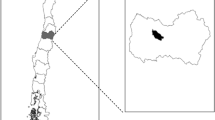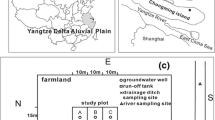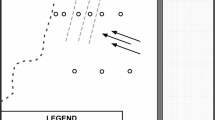Abstract
Many nutrients are lost from soil to water viatile drains. However, there are very few reliable studies of such phosphorus(P)losses under Swedish agriculture practices, especially in connection tofertiliser and slurry applications and related to nutrient balances. Tile drainlosses were measured from nine experimental plots in south-west Sweden; fourplots were measured for 7 years and five plots for 2–3 years. Cereals,mainly spring barley (Hordeum vulgare, L.) and oats(Avena sativa, L.), were grown in six plots, while oneplotwas cultivated with grass, timothy (Phleum pratense L.)andmeadow fescue (Festuca pratensis, L.), one with lucerne(Medicago sativa, L.) and meadow fescue (F.pratensis, L.), and the last one was a “set-aside” withgrass (Lolium perenne, L. and Trifoliumrepens, L.) that was neither fertilised nor used for crop removal.Attention was paid to the forms in which P was transported to water since thishas important ecological implications. Average losses of particulate P (PP)fromthe “set-aside land” was significantly lower than from the cerealproduction, but the average losses of soluble reactive P (SRP) and dissolvednonreactive P (DUP) were the same. Average loss of PP from the grass ley during 3years (0.09 kg per ha−1 y−1) wassignificantly less than the losses from cereal production. Total P loss of 0.3kg per ha−1 y−1 was equal to the averagelossfrom the Swedish monitoring network of observation fields. Compared to theaverage nitrate-nitrogen (NO3-N) leaching, which was 7 kg perha−1 y−1 from cereals, the NO3-Nleaching was very low from the plots with lucerne-grass and “set-aside”.After applying and directly ploughing in 80 kg ha−1 ofsuperphosphate for cereal production in November 1998, 0.6–1.8 kgSRP ha−1 y−1 was lost through the drain tiles.Surface application of cattle slurry in spring 1999 to the grass ley alsoresulted in a very pronounced increased base level of SRP. This paper documentsthe importance of applying slurry during dry conditions and of placingfertiliser into the soil according to crop requirements in the time perspectiveof one year.
Similar content being viewed by others
References
Addiscott T.M., Brockie D., Catt J.A., Christian D.G., Harris G.L., Howse K.R. et al. 2000. Vadose zone processes and chemical transport. Phosphate losses through field drains in a heavy cultivated soil. J. Environ. Qual. 29: 52–532.
Armstrong A.C. and Harris G.L. 1996. Movement of water and solutes from agricultural land: The effect of artificial drainage. In: Armstrong A.C. and Harris G.L. (eds), Advances in Hillslope Processes. John Wiley, Chichester, UK, pp. 187–211.
Cameron K.C., Rate A.W., Noonan M.J., Morre S., Smith N.P. and Kerr L.E. 1996. Lysimeter study on the fate of nutrients following subsurface injection and surface application of dairy pond sludge to pasture. Agric. Ecosystem & Environ. 58: 187–197.
Djodjic F., Bergström L., Ulén B. and Shirmohammadi A. 1999. Mode of transport of surface-applied phosphorus-33 through a clay and a sandy soil. J. Environ. Qual. 28: 1273–1282.
Djodjic F., Ulén B. and Bergström L. 2000. Temporal and spatial variation of drainage and phosphorus losses in a structured clay soil. Water Res. 34: 1687–1695.
Djodjic F., Bergström L. and Ulén B. 2000. Are tillage practices and incorporation of phosphorus fertilizers ways to reduce nd phosphorus losses caused by preferential flow? For 2nd International Symposium on Preferential Flow. Jan 3–5, 2001, Honolulu, Hawai.
Eder G. and Harrod T.R. 1996. Influence of grassland on soil erosion, aggregate stability and water quality. In: Parente G., Frame J. and Orsi S. (eds), Grassland and land use system. Proc of the 16th General Meeting of the European Grassland Federation Gorizia, Italy Sept 15–19, 1996. ERSA, Udinese, Italy.
Egnér H., Riehm H. and Domingo W.R.1960. Untersuchungen #x00FC;ber die chemische Bodenanalyse als Grundlage für die Beurteilung des Nährstoffzustandes der Böden. II Chemische Extraktionsmetoden zur Phosphor-und Kaliumbestimmung. Annal. Landwirtsch. Hoch. Schwedens 26: 199–215.
Ekholm P. 1998. Algal-available phosphorus orginating from agriculture and municipalities Monographs of the Boreal Environmental Research. Finish Environmental Institute, Helsinki No 11, 1998.
Eriksson J., Stenberg B., Andersson A. and Andersson R. 2000.Tillståndet i svensk åkermarrk och spannmålsgröda. Naturvårdsverkets rapport 5062. (In Swedish).
European Committee for Standards 1996.Water Quality. Determination of Phosphorus. Ammonium Molybdate Spectrometric Method. European Standard. EN 1189. Brussels, 18pp.
Foy R.H. and Withers P.J.A. 1995. The contribution of agricultural phosphorus to eutrophication. The Fertilizer Society, Proceedings No 365. 32 pp.
Hawkins J.M.B. 1996. Molybdate-reactive phosphorus losses in surface and drainage waters from permanent grassland. J. Environ. Qual. 25: 727–732.
Hooda P.S., Moynagh M., Svoboda I.F., Edwards A.C., Anderson H.A. and Sym G. 1999. Phosphorus loss in drain flow from intensively managed grassland soil. J. Environ. Qual. 28: 1235–1242.
Haygarth P. and Sharpley A. 2000. Terminology for phosphorus transfer. J. Environ. Qual. 29: 10–15.
Jordan C. and Smith R.V. 1985. Factors affecting leaching of nutrients from an intensively managed grassland in Country Antrim, Northern Ireland. J. Environ. Manage. 20: 1–55.
Kauppi L. and Niemi M. 1984. The role of runoff water phosphorus in eutrophication. National Board of Waters, Helsinki. Publ.Wat. Res. Inst. 57: 41–51.
´Lindén B. 1981. Ammonium-och nitrtkvävets rörelse och fördelning i marken. Metoder för mineralkväveprovtagning och analys. Report No 137, 1–117. Institute of Soil Sciences, Division of Soil Fertility and Plant Nutrition, Swedish University of Agricultural Sciences, Uppsala, Sweden, (In Swedish with English summary).
McCutcheon S.C., Martin J.L. and Barnwell J.O. 1992. Water Quality. In: Maidment D.R. (ed.), Handbook of Hydrology. McGraw Hill, Inc., New York.
Mattsson L. and Carlgren K. 1997. Plant nutrient experiments 1996. Yields, with plant and soil analyses. SLU, Soil Science, Soil Fertility and Plant Nutrition Div. Special Report No 7: 30–39. (In Swedish).
Mattsson L. and Carlgren K. 1998. Plant nutrient experiments 1997. Yields, with plant and soil analyses. SLU, Soil Science, Soil Fertility and Plant Nutrition Div. Special Report no 8: 26–35. (In Swedish).
Mattsson L. and Carlgren K. 1999. Plant nutrient experiments 1998. Yields, with plant and soil analyses. SLU, Soil Science, Soil Fertility and Plant Nutrition Div. Special Report no 9: 30–39. (In Swedish).
Mattsson L. and Carlgren K. 2000. Plant nutrient experiments 1999. Yields, with plant and soil analyses. SLU, Soil Science, Div of Soil Fertility and Plant Nutrition. Special Report no 10: 33–40. (In Swedish).
Schleicher and Schnell 1997. Membrane filters. Schleicher and Schnell, Postfach 4 – D-37582 Dassel, Fed. Rep. of Germany.
Stamm C., tiInstitute of terrestrial Ecology, Soil Physics, Grabenstr. 3, 8952, ETHZ, Switzerland Personal communication.
Turner B.L. and Haygarth P.M. 1999. Phosphorus leaching under cut grassland. Water Sci. Tech. 39: 63–67.
Turtola E. 1993. Phosphorus and nitrogen leaching during set-aside. In: Elonen P. and Pitkänen J. (eds), NJF seminar no 228: Soil tillage and environment June 8–10 Joikionen Finland. Scandinavian Association of Agricultural Scientists (NJF), Joikionen, Finland 88 Repport 88:, pp. 207–2
Turtola E. and Jaakkola A. 1995. Loss of phosphorus by surface runoff and leaching from a heavy clay soil under barley and grass ley in Finland. Acta. Agric. Scand. Sect. B. Plant and Soil 45: 159–165.
Torstensson G., Swedish University of Agricultural Sciences, Institute of Soil Sciences, Division of Water Quality, Box 7072, Uppsala, SE 750 05, SwedenPersonal communication.
Ulén B. 1997a. Förluster av fosfor från jordbruksmark. Naturvårdsverkets rapport 4731. (In Swedish).
Ulén B. 1997b. Nutrient losses by surface runoff from winter-green and spring-ploughed soil in the south of Sweden. Soil & Tillage Res. 44: 165–177.
Ulén B. 1999. Simulation of nitrate leaching before and after conversion to ecological farming. Biol. Agric. Hort. 17: 59–75.
Ulén B. and Persson K. 1999. Field-scale phosphorus losses from a drained clay soil in Sweden. Hydrol. Proc. 13: 2801–2812.
Ulén B., Johansson G. and Kyllmar K. 2001. Prediction model and long-term trend of phosphorus transport from arable land in Sweden. Agric. Water Manage. 49: 197–210.
Wagner R. 1974. A new method for automated determination in seawater using Auto-Analyser (in German). Technicon Symposium, Frankfurt am Main 1974.
Øgarden L., Kværner J. and Jenssen P.D. 1997. Soil erosion via preferential flow to drainage systems in clay soils. Geoderma. 76: 65–86.
Author information
Authors and Affiliations
Rights and permissions
About this article
Cite this article
Ulén, B., Mattsson, L. Transport of phosphorus forms and of nitrate through a clay soil under grass and cereal production. Nutrient Cycling in Agroecosystems 65, 129–140 (2003). https://doi.org/10.1023/A:1022133031584
Issue Date:
DOI: https://doi.org/10.1023/A:1022133031584




